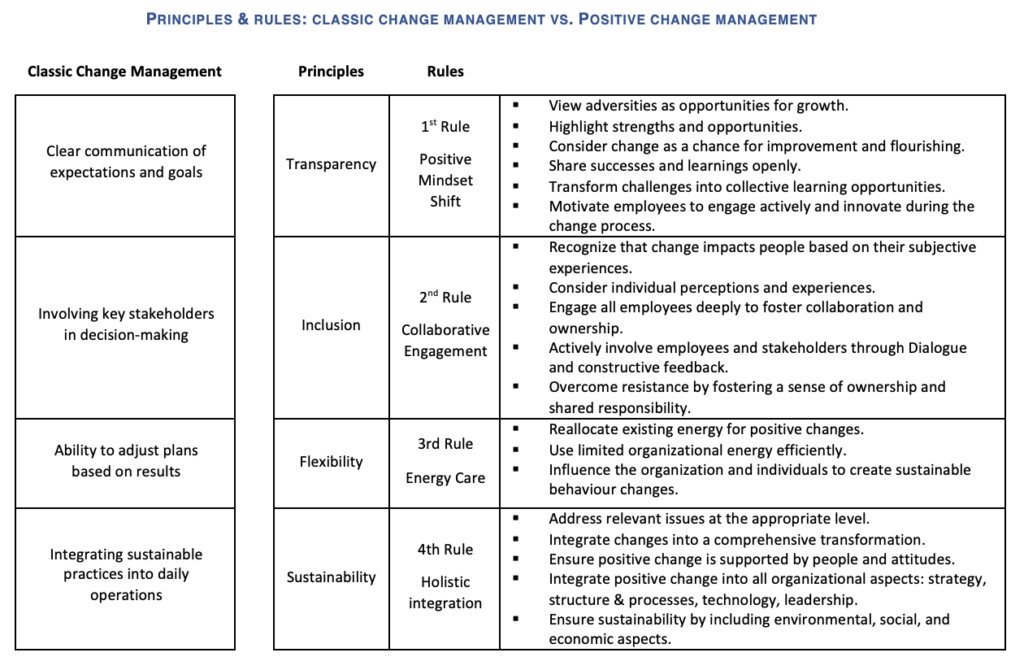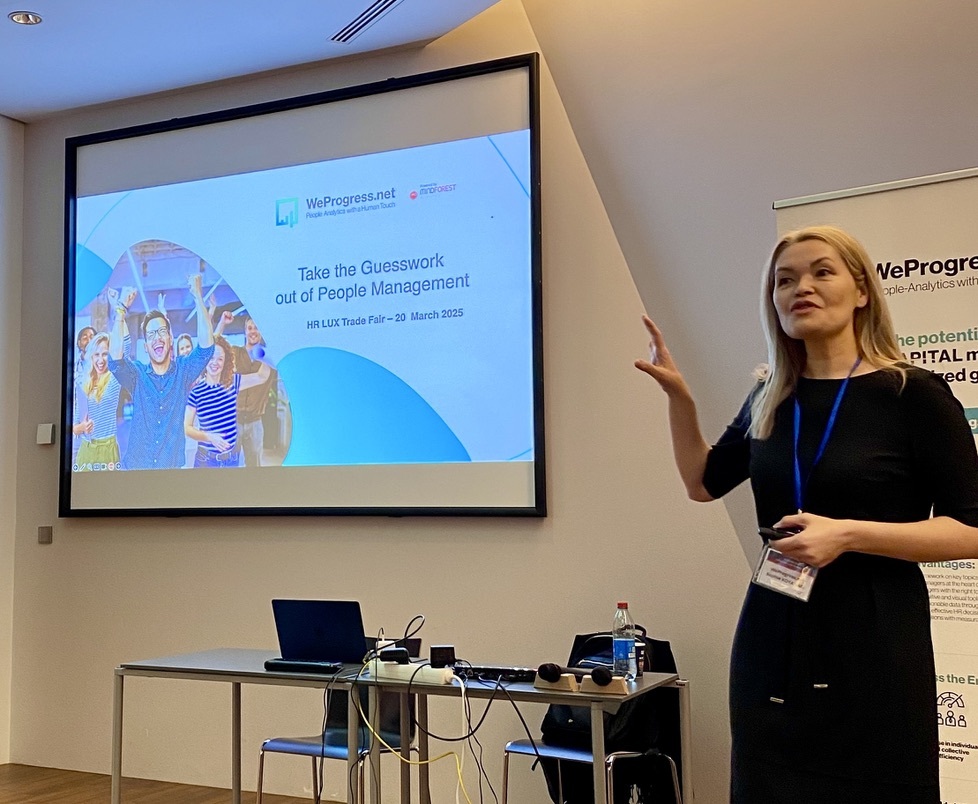Daring to Lead Positive Transformation: How can you implement and manage positive change with success?
- First published 27.06.2024 in the MindForest MindOpener
Downloaded 121 times
In the course of the coming months, MindForest will publish a series of articles on the subject of Positive Transformation
What if you could turn challenges into success? Crafting a Roadmap for Positive Transformation
In our previous article, “Daring to Lead Positive Transformation: What are the Pillars and Benefits for your Business Success?“, we explored the fundamentals and benefits of positive transformation. This approach can turn challenges into opportunities, enhance sustainability, and boost employee engagement. Positive organizational change is not just a reaction to challenges but a proactive mindset to create an optimal work environment that benefits both the organization and its employees. Implementing and managing positive change requires strategic thinking and a willingness to challenge norms. This article will guide you through three key phases of leading positive transformation successfully:
- Establishing a common framework with positive transformation principles,
- Developing a flexible Positive Strategy and process,
- Implementing actions and overcoming challenges
By embracing these phases, your organisation can navigate change complexities and foster a resilient, thriving workplace.
Phase 1 – Establishing the Framework for positive change in your organisation
A positive change in your organization goes beyond simply becoming different. It’s about making things significantly better. This involves asking crucial questions: What are the benefits of this change? What positive impact will it have on your organization? How does it align with your organisation’s values? Addressing these questions establishes a solid foundation for managing change.
Agreeing on Guiding Principles for positive transformation.
To initiate positive transformation, establish and communicate guiding principles from the highest level of your company, ensuring alignment across all organisational levels. These principles should consistently reflect:
Your organisation’s mission, values, vision, and objectives.
Key goals of positive organisational transformation, including:
- Enhancing the optimal functioning of your organisation, resulting in superior performance, beneficial relationships with the organisational environment, and a commitment to corporate social responsibility.
- Promoting psychosocial well-being by fostering a positive and inclusive culture.
- Improving workplace quality of life through initiatives that boost employee engagement, satisfaction, and resilience.
Adopting rules to drive positive transformation

Phase 2 - Developing a flexible strategy and process for Positive Transformation
The positive change management process differs from traditional change management in its approach:
Identifying organisational needs and strengths
Rather than diagnosing deficits, positive transformation begins by identifying the organisation’s strengths and specific needs. Assess employee strengths, effective processes, and opportunities for improvement. Use tools like SOAR (Strengths, Opportunities, Aspirations, Results) and Appreciative Inquiry to amplify these strengths. These disruptive tools engage teams in constructive dialogues to identify strengths and develop strategies to amplify them.
Defining and developing an inspiring Vision and Objectives
Creating an inspiring vision involves integrating the aspirations and contributions of employees (Cameron & Quinn, 2011) and aligning the organisation’s goals with positive and sustainable values. A clear, inspiring vision, transparently communicated, guides the organization toward a desirable future. Unlike traditional change management, which often relies on reactive responses, positive transformation requires a proactive approach. This vision, developed with employee input, fosters commitment and drives the organisation forward.
Establishing strategic planning and action implementation
Developing a flexible strategy and process for positive transformation involves several key steps:
- Develop flexible and adaptive strategies:
- Focus on innovation and continuous improvement. Use insights from successful behaviours to create formal initiatives.
- Create opportunities for collective learning:
- Managing change involves learning new behaviours and creating new ways of thinking. Build learning communities of practice that promote collaboration and knowledge sharing.
- Design a detailed strategic plan:
- Integrate sustainable and ethical initiatives into all aspects of the transformation.
- Balance short- and long-term objectives:
- Prioritise initiatives that provide sustainable benefits and align with the long-term vision.
- Maintain open and transparent communication:
- Ensure communication is clear, coherent, and bidirectional, using various channels to reach all members of the organisation.
- Use a solution-focused approach:
- Concentrate on solutions rather than problems, leverage existing resources, and consider past, present, and future possibilities. Recognize each case is different and avoid ill-fitting theories.
- Track well-being metrics alongside KPIs:
- Besides performance indicators, use metrics for employee well-being and satisfaction (Luthans et al., 2007).
- Regular evaluations and feedback:
- Conduct periodic evaluations to analyse progress and adapt strategies based on positive and constructive feedback.
Phase 3 - Implementing actions and overcoming challenges
Positive transformation in a company requires an iterative and continuous approach, addressing multiple levels: organisational, teams, and individual. The actions taken not only help overcome the inherent challenges of change but also amplify positive successes.
Organisational Actions
To transform positively at the organisational level, develop psychological capital by enhancing hope, efficacy, resilience, and optimism through targeted programs. This strengthens employee confidence and adaptability. Employ a strength-based management approach to identify and leverage the unique strengths of individuals and teams, aligning roles to boost performance and engagement. Create environments that support autonomy, skill development, and high-quality relationships, fostering intrinsic motivation and flow. Encourage social innovation through projects with positive societal impacts, such as collaborating with local communities.
Team-Level Strategies
Effective teamwork and collaboration are crucial. Promote healthy team dynamics by regularly assessing and improving how teams work together, ensuring each member feels valued. Implement the Healthy and Resilient Organisations (HERO) model to improve the work environment, especially during change. The HERO model enhances both employee well-being and organisational health through practices like promoting work-life balance, wellness programs, and open communication.
Transformational leadership encourages shared leadership behaviours that promote knowledge sharing and collective goal achievement. This approach enhances team performance and drives the organisation toward its transformation goals. By encouraging creativity, participation, and a positive attitude, transformational leaders ensure every team member is motivated and rewarded, contributing to a resilient workplace.
Individual Focus and Well-Being
Generating positive emotions in the workplace is key to maintaining high levels of employee engagement and creativity. A supportive work environment where positive emotions thrive enhances cognitive processes and innovation. Build psychological capital through programs that develop hope, self-efficacy, resilience, and optimism, ensuring employees are better equipped to handle change. Foster positive attitudes and behaviours through training and development opportunities. Implement well-being programs that support a healthy work-life balance, personal and professional growth, and overall well-being. Prioritising employee well-being creates a motivated and productive workforce, crucial to successful organisational transformation.
Implementing Positive Transformation: How can this be Achieved?
By embracing these phases, your organisation can navigate change effectively and foster a resilient, thriving workplace. For optimal results, consider partnering with experts like MindForest, who specialize in guiding organisations through positive transformations, ensuring enhanced performance and sustainable success.
Contact us today to learn more.
Article written by Florence Delacour Le Petit
WANT TO RECEIVE OUR LATEST THOUGHT LEADERSHIP CONTENT?
Related posts
 Take the Guesswork out of People Management
Take the Guesswork out of People Management
 From processes to people: achieving quality
From processes to people: achieving quality
 Daring to lead Positive Transformation: What if Positive Emotional Capital was your key to sustainable change?
Daring to lead Positive Transformation: What if Positive Emotional Capital was your key to sustainable change?
 Why hire Change management professionals? We can do it alone!
Why hire Change management professionals? We can do it alone!
 Digital Transformation and Change Management: Lessons shared in an event hosted by Cebi and MindForest
Digital Transformation and Change Management: Lessons shared in an event hosted by Cebi and MindForest




